Hummingbirds are majestic birds that we watch in awe as they chase each other around our backyards. For some species of hummingbirds, you’ll notice they disappear in some seasons. Other species seem to stick around in some areas. If you’re wondering how hummingbirds migrate, the answers may surprise you.
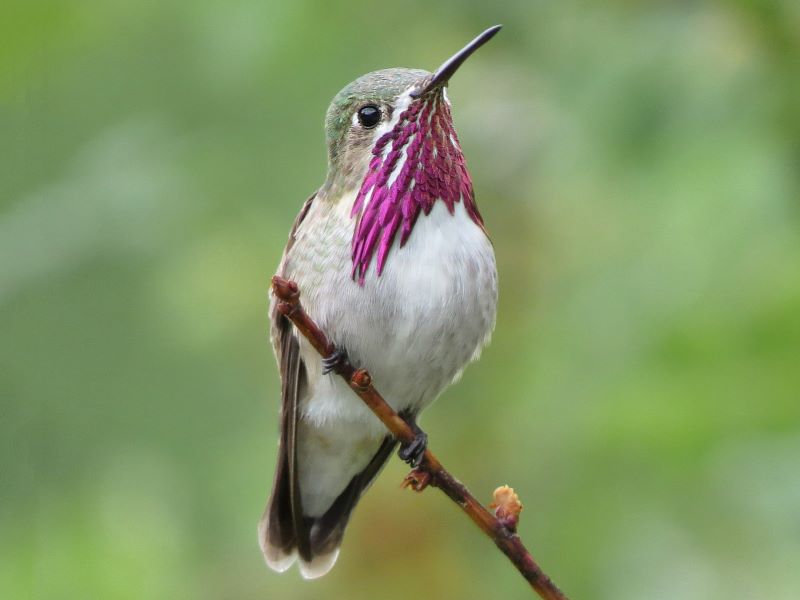
Preparation For Migration
Hummingbirds have two migrations that go north and south each year. How hummingbirds migrate is different than many other birds. These little guys and gals prepare intensely for months before they get ready to hit the journey. Their migratory journey may span thousands of miles, so they have to prepare with all of their energy. These birds are the smallest birds in the world, yet their efforts are astounding. The hummingbirds that migrate to the north usually go from Mexico and South America up to Canada. This is usually a solitary journey that ends at their breeding grounds. They want to claim the best territories for themselves. Sometimes, this migration will begin as early as February to ensure they get the best grounds. They may finish in the middle of May in Alaska or Canada.
The hummingbirds that migrate in the fall follow something similar. They usually leave in late July with the last ones arriving in the southern United States at the end of October. Sometimes this migration will end up with hundreds of birds at your feeders. It’s a neat sight for most people. These hummingbirds are stocking up on energy before they jump into the next phase of their “vacation.”

Dietary Needs Of Migrating Hummingbirds
Put yourself in the tiny feet of a hummingbird. It can eat all day, but those flapping wings burn off all of its energy. Their dietary needs for migration are grand. Some species of hummingbirds double their weight from the time they prepare for migration until the day they fly away.
These hummingbirds don’t stay fat and happy too long either. They lose all of the grams they have gained and more during their journey. This is why it is critical that they get as much food fuel as possible. They need all of the extra weight they can get for their travels. Their heart is beating about 1,200 beats per minute when they are flying. This means their wings flutter about 53 times per second. Their non-stop migration trip means a huge amount of energy.
To prepare, hummingbirds will often eat half of their body weight in food each day. They’ll consume nectar and insects all day and night. Since they don’t know where their next meal will happen during their trip, they boost their nectar intake during migration.
Nectar And Flower Importance
The breeding and migrating season of hummingbirds is directly tied to nectar in blooming flowers. When flowering plants start to bloom, hummingbirds are ready to get their nectar. They need to store up all of the food they possibly can before their flight. When they land on a backyard feeder with an abundance of nectar around it, they treat it like a buffet. Flowers are critical to their migration journey. They will often follow a migration route that corresponds with flowering resources.
Insect Importance
If you think hummingbirds just eat nectar and sugar water, you’re wrong. They love insects as well. They will even steal a carcass from a spider web. These little guys need lots of protein for their migration efforts. Don’t think they won’t go for insects that are almost as large as them.
State Of Torpor
Some hummingbird species fight the cold with torpor. While they cannot handle freezing temperatures for long, they can handle the cold for a bit. They will shut down their body functions, even breathing, for a short amount of time. Their body temperature drops by 50 degrees and their heart almost stops beating. When the temperatures rise, the birds then wake up. If you see a hummingbird in torpor, it will hang upside down for a tree or your feeder. Don’t try to wake it up.
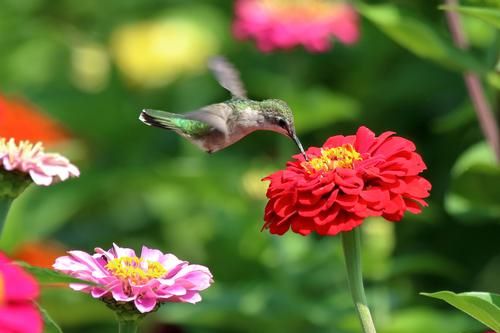
The Why Of Migration
Besides wondering “how hummingbirds migrate,” you have to wonder why as well. These little birds first developed in South America. They are believed to have arrived there from Asia over 22 million years ago. Some of the species began moving into Central America and the Caribbean. They finally made their way into North America. The hummingbirds seemingly settled in areas with the most food. They didn’t have much competition for territory and food. The cool air drove them south each year like many other birds.
Now there are over 300 hummingbird species in the world. Only 12 to 15 of these species actually migrated into the US on a regular basis. A fewer amount of the species migrate all the way into Canada and Alaska. The why and how hummingbirds migrate is important to all species of these birds because they are so tiny, yet show the world size doesn’t seem to matter when it comes to survival.
Males Vs. Females
In most hummingbird species, the male will leave for migration before the female. This may take a few days or even weeks. Since they don’t need to fly together, each can take their own specific route. This helps each bird find their own pile of food. They won’t fight over the same food if they fly apart. Hummingbirds are simply too small of creatures to benefit from flying together like larger birds.
Length Of Migration
Their fall journey usually takes about two weeks. This is give or take for some species, and it also depends on the weather and food. Some hummingbirds will fly all the way south to Panama. This might take longer. Hummingbirds can fly about 35 miles per hour. This means if they don’t rest or stop to eat, they can make their journey in a week. During the fall, they may stop to feed at your feeder. This would only last a day or two as they get their fuel needed for the journey.
Helping To Fly
Hummingbirds have the fewest amount of feathers of any other bird species. They only have about 1,000 to 1,500 feathers. This helps with their famous flights. Even though they are tiny, the fewer feather amount also helps keep them lightweight.
Issues During Migration
How hummingbirds migrate is just as important as the issues they may encounter during this journey. Sometimes hummingbirds don’t store up enough energy to make their long flight. They will sometimes take temporary refuge on boats or oil rigs. They just need to rest a little bit to get back into flight. The weather may impact migration to a certain degree. Storms and winds can hold up the flight. If the weather is too bad, the migrating hummingbirds may need to stay in a safe location for a few weeks before they can travel in better weather.
It isn’t the easiest thing for researchers to get data on migrating hummingbirds. The little birds don’t fly in flocks, so it is often hard to track one down. They are so small that they are hard to band. The technology for transmitters is fast, but sometimes not as fast as these little flyers.
Age Of Migrating Birds
Juvenile hummingbirds may start their journey later than mature hummingbirds. The younger birds need a longer amount of time to build up their strength before they are ready to fly on the long journey. The birds that hatch earlier in the year may also leave earlier.
Traveling Alone
These birds don’t travel in flocks. We’ll get to the myths about flying with geese later, but hummingbirds fly on their own. They decide on their own when it’s time to depart. Scientists think this decision is often based on environmental triggers. They may start to realize the angle of the sunlight is different during the times of the year, may notice a drop in their food selection, and may start to see natural signals that tell them it’s time to fly. They then travel about 500 miles to their destination. You can sometimes see them over the Gulf of Mexico. They fly for about 22 hours during migration.
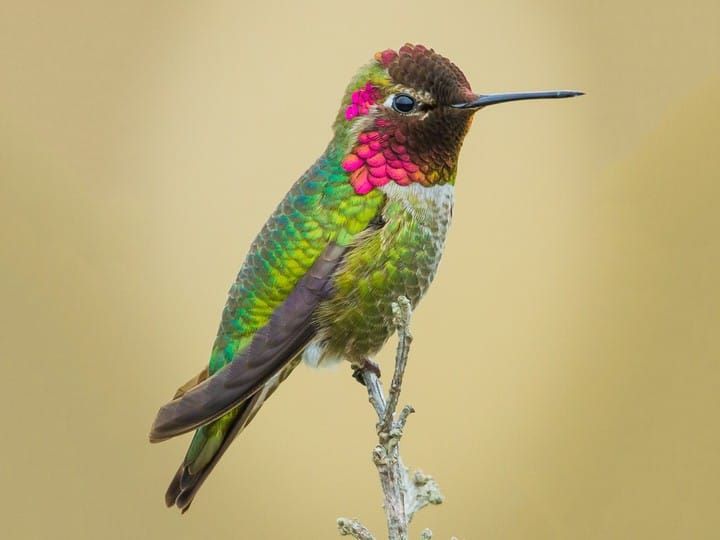
Migration Of The Ruby-throated Hummingbird
The Ruby-throated Hummingbird spends most of the winters hanging out between northern Panama or southern Mexico. These birds are solitary, so they may migrate wherever they want in this range by themselves. They usually spend their time preparing for the next phase of migration.
By December, the molting of the hummingbirds starts to take effect. They spend all of their time binging on insects and nectar to store all of their energy. The slowest month for the Ruby-throats is January. Their feathers are coming in, so they spend their time eating more. By February, they have enough stored food to make their journey. They’re ready to fly up north with all of this energy. Breeding season is soon, so they don’t have time to waste.
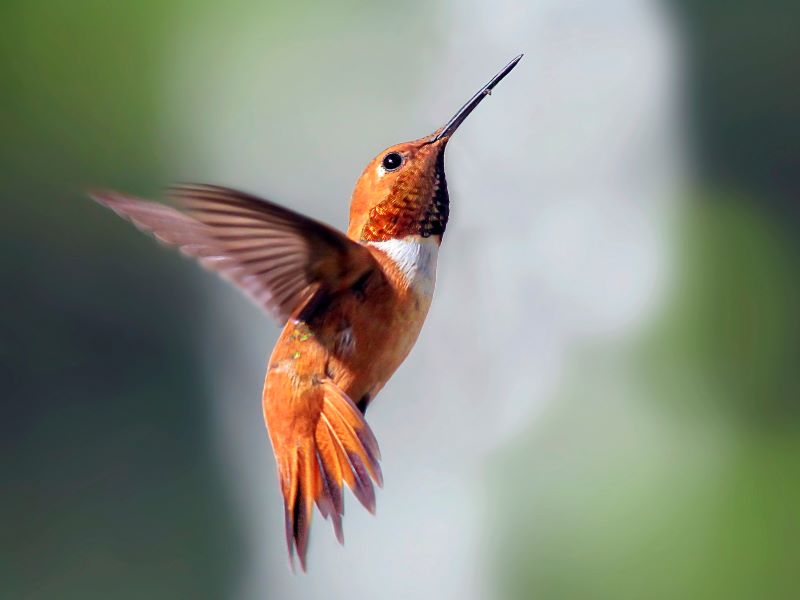
Migration Of The Rufous Hummingbird
The tiny three-inch-long Rufous Hummingbird throws a wrench in all people know about how hummingbirds migrate. These tiny birds make one of the longest journeys of all the known birds in the world. They travel about 3900 miles. This is pretty much equal to 78.4 million times their body length. The Arctic Tern might make a journey of 11,000 miles, but its journey is less than 52 million times its body length. The Rufous Hummingbird makes a clockwise migratory journey. They leave Mexico in spring, and they arrive in Canada and the Northern United States by May. They’ll sometimes start to fly back as early as sometime in July. These fast birds are on the IUCN Near Threatened species list due to their declining population. More of their habitats are lost each year. One thing that is different about these birds is they are well-adapted to the cold. They can migrate into areas where the temperatures at night dip below freezing. They don’t mind quick cold snaps.
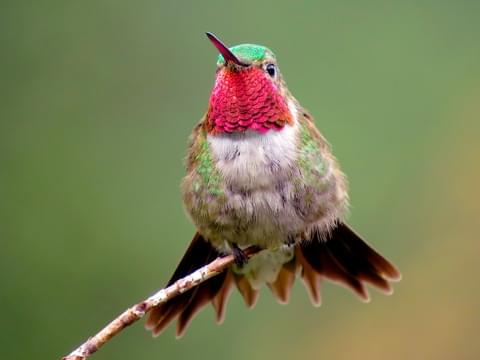
The Migration of The Broad Tailed Hummingbird
The Broad Tailed Hummingbird only partially migrates. It all depends on their northern range in the colder seasons. No one knows their exact migration route. They usually end up in southern Mexico and Guatemala in the winter. The hummingbirds already living in this area don’t migrate at all. They show sedentary behavior. The male is the first to migrate, then the females follow.
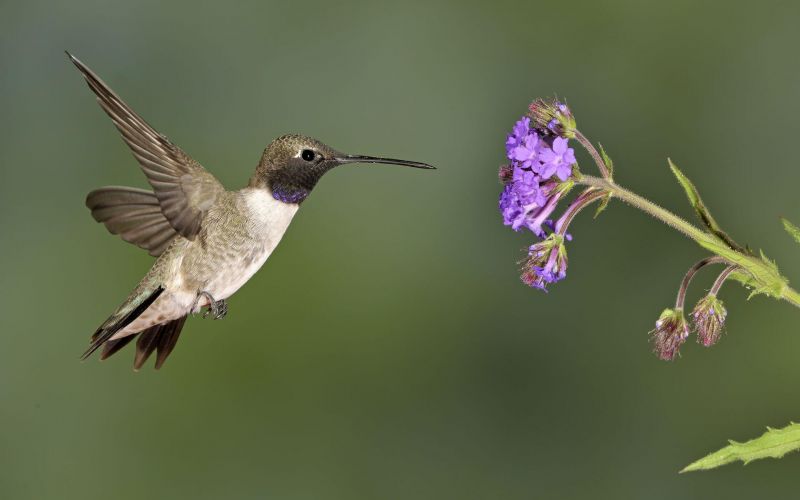
The Migration of The Black-chinned Hummingbird
Black-chinned Hummingbirds are found in many places of the western US. This species of hummingbirds adapts to many different areas that are warm. They will even show up in urban locations. After their breeding season, the adult hummingbirds like to move to higher elevations. They love mountain flowers before they fly south during the fall. Most Black-chinned Hummingbirds make their way to western Mexico or along the Gulf Coast. Though these birds were once almost endangered, their numbers are on the rise. This could be because of a rise in backyard feeders and their tolerance to different temperatures.
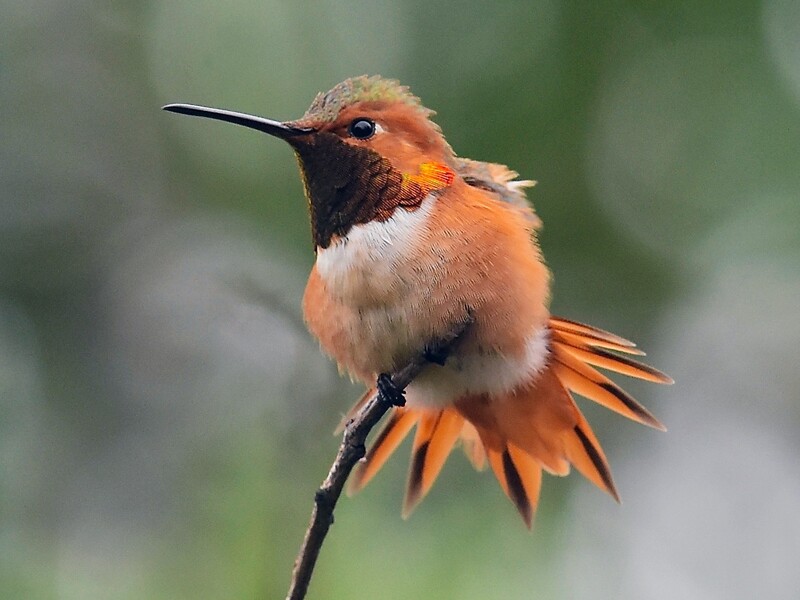
The Migration of The Allen’s Hummingbird
Allen’s Hummingbirds don’t leave their places in the winter in December. This means they get to their destination of Oregon and California in January. This is just in time for them to get to enjoy the winter wildflowers. One strange thing about Allen’s Hummingbirds is that the male and female have different habitats. Males like to live along the coastal shrubs. Females like to live in the forests where they can build their nests. The subspecies of Allen’s Hummingbirds include the Selasphorus sasin sasin that migrates to central Mexico and the S. s. sedentarius that stays in the southern part of California. There has been over an 80 percent decline in the population of the Allen’s Hummingbird in the past two decades.
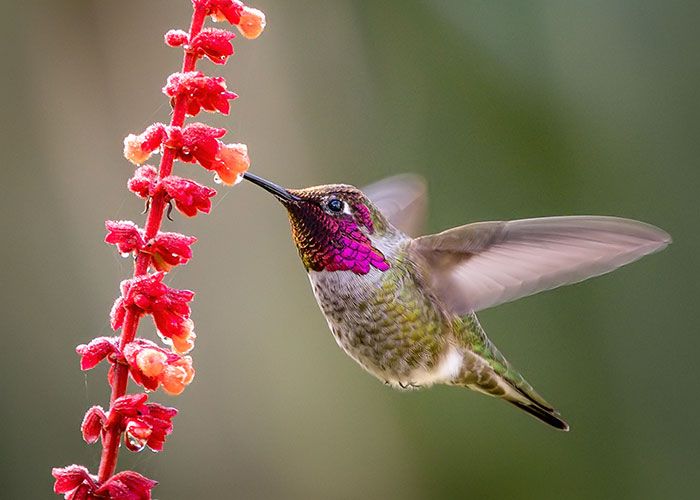
The Migration of The Anna’s Hummingbird
Anna’s Hummingbirds will also throw you for a loop with their migration efforts. The fact is that they do not migrate at all. Some do move short distances to look for other food services. They live in a habitat that stretches from southern Canada to northern Mexico. This has changed over the years. At the first of the 20th century, these birds had a very small breeding range. They were only found in Baja, Mexico and parts of southern California. As exotic flowering trees sprouted along the West Coast, these hummingbirds moved in. Their population is now booming, also thanks to the backyard feeders.
Migration Myths
One of the most popular myths about hummingbird migration is that they migrate on the backs of strong birds. This might seem normal since hummingbirds are so small, but it is not true. These tiny birds, only a few inches long, are able to make the long adventures on their own. They don’t need to fly on the back of geese. This was supposedly a myth made up by the Pilgrims or cavemen.
Some people think hummingbirds have to migrate to stay alive. This is not true because there are species like the Anna’s Hummingbird that don’t migrate at all. Some of them are okay with any type of weather. The Rufous Hummingbird can even handle the late spring storms in Alaska.
One strange myth is that hummingbirds sleep in the mud when they aren’t migrating. They don’t actually hibernate, but some people do confuse this with their state of torpor. Mud doesn’t have anything to do with torpor.
How To Help Hummingbirds Migrate
You can help these sweet birds with their migration journey. There is a myth in the birder world that feeding hummingbirds actually prevents them from migrating. The truth is that these birds are much smarter than most people give them credit. They don’t just stay in one place thinking they can survive throughout the whole season. If you’re a smart birder, you’ll know to leave out your feeder from spring into the late fall. They may need an early or a late food source.
Plant flowers to bring the hummingbirds into your yard with this natural food for them. Nectar is great for them at any time.
When you provide nesting materials for breeding, you’ll provide them an early home. They won’t have to fight each other for nests when they arrive.
Try to keep their nectar from freezing so they can access it even if they are late on their migration journey.
Always keep your hummingbird feeders clean. Replace old, spoiled nectar with fresh, clean sugar water.
In Conclusion
It will amaze you that your backyard hummingbird friends seem to come and go at the same time every year. These tiny birds can live up to 12 years. This all depends on their environment, but they are true survivors. They’re remarkable in the way they travel and prepare to migrate each year. Now that you know how hummingbirds migrate, you’ll know what to expect each year with different species. These tiny birds make a huge impact on the migration efforts of all of the birds in the world.
Related
- Along their migration path, they may want to take a pitstop in your backyard to enjoy some food from your feeder. Read one of our latest articles on how to keep ants out of your hummingbird feeder to keep their food safe.
- Interested in learning more about hummingbirds? Check out 10 hummingbird facts and myths and learn some more.
Leave a Reply